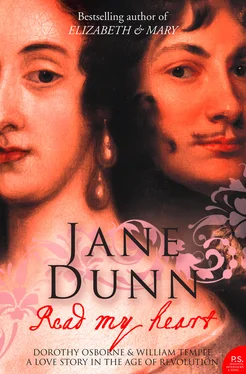Under the brilliance of this evocation of the centuries-old pattern of country life and the idyll of an English summer day lay a sense of personal frustration. While the herd girls were unaware, Dorothy believed, of the sublime simplicity of their lives she, the young unmarried daughter of the estate, was over-conscious of her own youth idled away while she waited on the will of others. She was richer, better educated and living in greater comfort than the girls minding the cattle, yet she had to look to marriage for purpose in her life and seemed in part to envy the useful and natural freedom of their days. Where she was solitary they had comradeship; where she was weighed down with her heavy seventeenth-century dress, its tight bodice and bulky petticoats and all the expectations laid upon a lady of quality, they were less encumbered, sprightly and carefree. In reality the lives of these country girls were hard and narrow, and winter would have made their labour much less enviable, but Dorothy’s reaction to their lively conversation and the simplicity of their working lives, making them ‘the happiest People in the world’, revealed the feeling that her own life lacked autonomy and purpose.
The civil war that began in 1642 only destroyed for a while this ordered rural life, but the Osbornes’ easy prosperity was gone for ever. The effects on the family were catastrophic but commonplace. Two of Dorothy’s brothers died in action fighting for the king; Henry, lieutenant colonel of foot, at the Battle of Naseby in 1645 when he was thirty-one and Charles, only seven years older than Dorothy, also lieutenant colonel of foot, was killed at Hartland in Devon the following year when he was twenty-six. The depredations went deep and wide: her father’s annual income was reduced by 90 per cent to £400 per annum; * both parents were prematurely aged by the hazards and relentless strain of their circumstances, and Dorothy herself, temporarily at least, lost her belief in a benign world. But along with the destruction and suffering of war also came opportunity. Civil war particularly touched everyone and it affected Dorothy’s life as deeply as any. Most significantly, it interrupted the rural seclusion of her life, introducing her to new and at times alarming experiences, and it disrupted the marriage dance choreographed for her by the wider family.
Dorothy’s early life had been lived against the uncertain backdrop of Charles I’s personal rule. After his relationship with a succession of parliaments had broken down over intractable financial, political and religious issues, the king had dismissed his 1629 parliament with little intention of meeting them again. He became increasingly isolated from his own people who were suspicious that his private relationships, with his Catholic wife Henrietta Maria and reckless favourite Buckingham, until his assassination in 1629, exerted a sinister influence on his public policies. After what was called the ‘Eleven Years’ Tyranny’, Charles was forced to recall parliament in 1640 and agree to a raft of concessions, limiting his power and redressing some of the grievances against him. These agreements he subsequently ignored. Having lost the trust of a thoroughly disenchanted parliament, the king withdrew from Westminster and in the summer of 1642 raised his standard at Nottingham, marking the formal start of civil war.
Dorothy was fifteen when the country’s gentry and nobility were forced to choose between their king or their elected parliament. This choice could be a matter of life and death, placing their fortunes, their lives and the lives of their retainers at the disposal of their masters at war. There was no doubt that Dorothy’s father was one of the king’s men. Her immediate family seems to have been solidly royalist, with four brothers at least available to serve their king, two of whom were sacrificed in the process.
So it was that loyal Sir Peter Osborne was called upon once more to defend Castle Cornet, the only royalist stronghold in Guernsey, an independent-minded island long attached to its Presbyterianism, which had declared quickly for parliament. By comparison, its larger neighbour, Jersey, remained royalist largely due to the pervasive influence of the all-powerful Carteret family. Lieutenant governor of the island at the time was Captain Carteret, later Sir George Carteret, who was a man of outstanding courage and capability as a naval commander but also acquisitive and ambitious for himself. He had freedom of movement and action while Sir Peter stoically endured real privation in his attempt to hold Castle Cornet against a hostile populace. Carteret’s opportunism and Sir Peter’s incorruptible and ingenuous nature, together with his reliance on Carteret for much of the provisions needed by his garrison, meant conflict between the two governors was inevitable.
When Sir Peter Osborne returned to Guernsey in 1642 the inhabitants were already ill-disposed towards him. They had long memories of the unwelcome garrison he had brought over during the fear of invasion in 1627 and imposed on them for two years. There was natural antipathy anyway towards the mainland and previous governors who had looked to help themselves to the lion’s share of island revenues. The inhabitants’ independence was also fostered by the republican sensibilities of many of their clergy, some of whom were French Calvinists escaping from the cruel persecutions of their own king. Although there were no hostilities at first, from the beginning of the civil war Sir Peter seems to have lived in the castle almost entirely separate from the townspeople and islanders. This they resented, eventually listing their complaints against him the following year in a letter to the Earl of Warwick, whom Cromwell had appointed as governor of Jersey and Guernsey. The gist of these complaints was Osborne’s aloofness from the islanders and his misuse of the king’s grants by building promenades and genteel accommodation within the castle rather than bolstering its fortifications and providing extra billets for the soldiers.
By the spring of 1643, parliament had issued instructions to the newly appointed commissioners in Guernsey to seize Sir Peter Osborne and convey him back to them to answer for his disobedience and various other misdemeanours. When the commissioners attempted to fulfil this order, Sir Peter refused all compromise and threatened to destroy the town, firing several cannon shots over it and even some into it, terrifying the inhabitants. He was defiant, truly believing that no human agency could challenge King Charles’s right to rule the British Isles, and determined to expend whatever blood or fortune it took in defending his particular belief through the agency of his governorship of this one fort in a very small island. Sir Peter Osborne’s answer to the parliamentarian governor of the islands was morally clear, eloquent and quintessential of old royalist sentiment:
these islands being no ways subordinate to other jurisdiction, but to his majesty alone, as part of his most ancient patrimony enjoyed by those princes, his glorious predecessors, before that, by claim or conquest, they came to have interest in the crown of England, – no summons, by virtue of what power soever, hath command here, nor can make me deliver it up to any but to him by whom I am trusted, and to whom I am sworn, that have never yet made oath but only to the king. And God, I hope, whose great name I have sworn by, will never so much forsake me but I shall keep that resolution (by yourself misnamed obstinacy) to maintain unto my sovereign that faith inviolate unto my last. 23
In a time of conflict and upheaval many decisions of allegiance were made out of opportunism or self-preservation, but there were just as many men and women who stood by their passionately held principles and suffered the consequences. This statement of resolve epitomised the conservative loyalty and unshowy courage of the idealised cavalier spirit. Sir Peter did not just mouth ringing sentiments, he intended to live by them. He stockpiled what ammunition and provisions he could in preparation for a long siege. He attempted to instil a military discipline in his garrison by threatening draconian punishments for any insubordination. A brawling soldier would have his right hand chopped off, and a similar punishment would be meted out to anyone who merely threatened to punch an officer: whosoever actually struck his superior ‘shall be shot to death’. 24
Читать дальше












